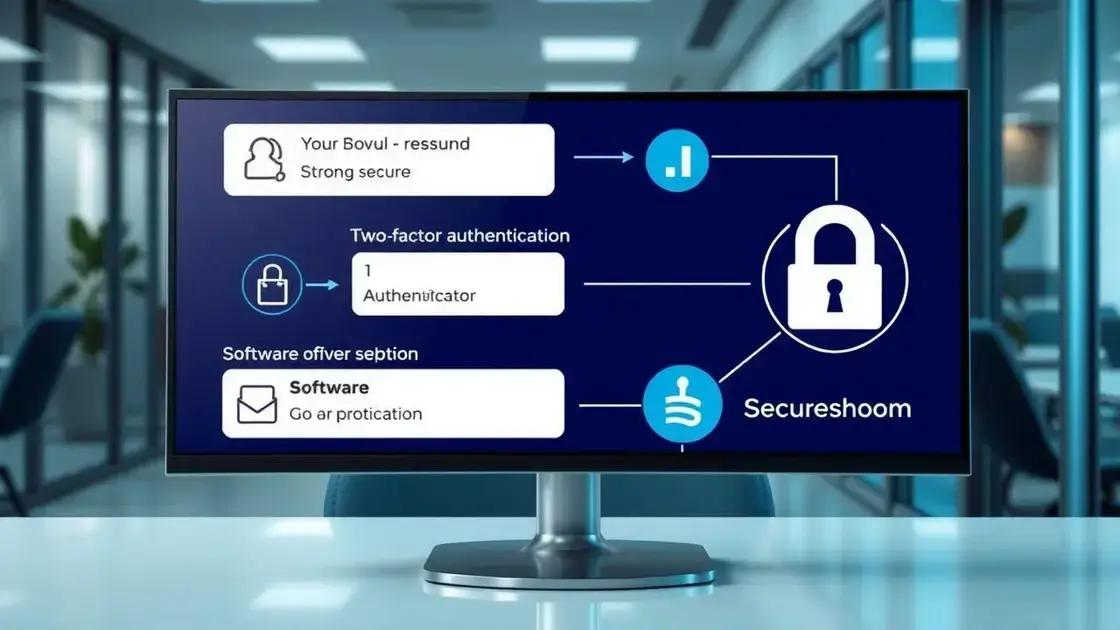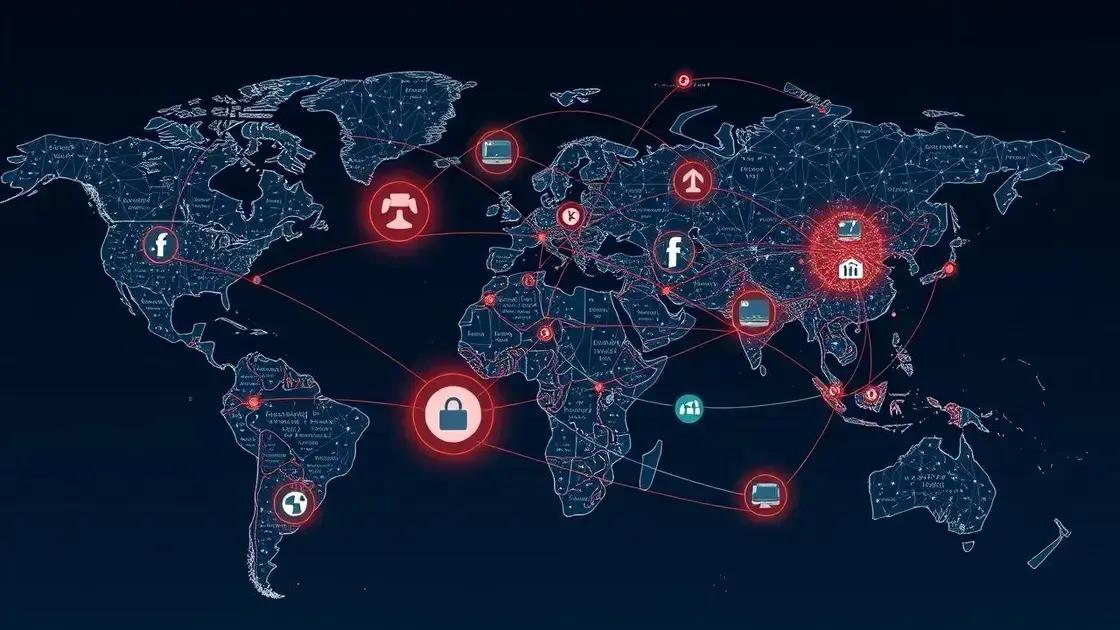Cybersecurity threats: are you prepared for the risks?

Anúncios
Understanding cybersecurity threats involves recognizing types such as malware, phishing, and ransomware, while implementing best practices and employee training to protect data and mitigate potential risks effectively.
Cybersecurity threats have become a daily reality for businesses and individuals alike. It’s crucial to recognize how these risks can affect your online safety. Ready to dive deeper?
Anúncios
Understanding different types of cybersecurity threats
Understanding the different types of cybersecurity threats is vital in today’s digital age. These threats can take many forms, and recognizing them is the first step towards protection.
Common Types of Cybersecurity Threats
Cybersecurity threats can be categorized into a few main types. Knowing these can help you identify potential risks. Some of the most prevalent threats include:
- Malware: This category includes viruses, worms, and ransomware that can harm your system.
- Phishing: Attackers use deceptive emails to trick users into revealing personal information.
- Denial of Service (DoS): This attack overwhelms systems, making them unavailable to users.
- Insider Threats: Employees or partners with access to sensitive information may misuse it.
Knowing the characteristics of these threats is just one aspect of cybersecurity. There are other evolving threats that are equally challenging. For instance, advanced persistent threats (APTs) target specific organizations, often remaining undetected for long periods.
Anúncios
Emerging Threats
As technology advances, new types of threats also appear. IoT vulnerabilities can put connected devices at risk, while cloud security issues can arise from inadequate protection of cloud services. It’s crucial to stay informed about these changes.
Awareness is a key part of defense. Regularly updating your knowledge about cybersecurity threats can help you stay ahead of attackers. This vigilance allows individuals and organizations to implement effective strategies and tools to combat potential risks and safeguard their information.
Common signs of a cyber attack
Recognizing the common signs of a cyber attack is essential for protecting your data and systems. Many people overlook the warning signs until it’s too late. By being aware of these indicators, you can take action before damage occurs.
Unusual Account Activity
One of the first signs of a potential cyber attack is unusual activity in your accounts. This could include unexpected password changes, unfamiliar login locations, or new devices accessing your accounts. Always monitor your accounts for any suspicious behavior.
Slow System Performance
If your devices suddenly start acting slower than usual, it might indicate an ongoing attack. Malware can consume resources and slow down performance. This includes frequent freezing or crashing of applications as well.
- Frequent pop-ups: Excessive pop-up ads could be a sign of adware.
- Missing files: If files go missing without explanation, that could indicate data theft.
- Unusual network activity: Unexpected spikes in data usage may suggest unauthorized access.
Additionally, watch for strange messages or emails. If you receive unusual communications from your contacts, it could be a sign that their accounts were compromised. Cyber attackers often use hijacked accounts to spread malware further.
Alerts from Security Software
Your security software is designed to help you detect and defend against attacks. If you receive alerts indicating threats or malware detection, take them seriously. Regularly updating your security software can enhance your defense against these threats.
Another common sign is the appearance of unfamiliar programs on your devices. If you notice software you didn’t install, it may be malicious. Always verify what applications are running and remove anything suspicious.
Best practices for protecting your data

Protecting your data is essential in a world full of cybersecurity threats. Implementing best practices can significantly reduce your risk and enhance your overall security posture.
Use Strong Passwords
One of the simplest ways to protect your data is by using strong passwords. Avoid common phrases and use a mix of uppercase and lowercase letters, numbers, and symbols. Consider changing your passwords regularly and never share them with others.
Enable Two-Factor Authentication
Two-factor authentication (2FA) adds an extra layer of security. Even if your password is compromised, a second form of verification can help prevent unauthorized access. Most services offer 2FA options, so use them whenever possible.
- Monitor Your Accounts: Regularly check your account statements and online transactions for any unusual activities.
- Backup Your Data: Regular backups can protect you from data loss, especially during a cyber attack.
- Keep Software Updated: Make sure to regularly update your operating systems and applications to patch any security vulnerabilities.
Staying informed about security threats is another crucial element. Familiarize yourself with the latest types of cybersecurity threats and how they may impact your data. This awareness allows you to identify and mitigate risks more effectively.
Educate Yourself and Your Team
Training is vital in a secure environment. Educating yourself and your team about safe online practices can prevent human errors that lead to data breaches. Regular training sessions can empower employees to recognize suspicious emails and phishing attempts.
Remember to limit access to sensitive information. Only authorized personnel should have access to critical data, minimizing potential exposure. This practice helps keep your data safe from internal threats as well.
The role of employee training in cybersecurity
Employee training plays a critical role in enhancing cybersecurity within organizations. Proper training ensures that all staff members understand the potential risks and know how to respond effectively when threats arise.
Awareness of Cyber Threats
Training helps employees become aware of various cybersecurity threats, such as phishing, malware, and social engineering. By recognizing these threats, employees can avoid falling victim to attacks. Regular updates and refresher courses keep this information fresh and relevant.
Best Practices in Data Protection
Employees should be taught the best practices for protecting sensitive data. This includes using strong passwords, recognizing suspicious emails, and understanding the proper channels for sharing information. Reinforcing these practices helps to secure sensitive company data.
- Regular Training Sessions: Schedule training at least once a year to keep cybersecurity knowledge up to date.
- Simulated Phishing Attacks: Conduct tests to help employees recognize real phishing attempts.
- Encourage Open Communication: Create a safe space for employees to report suspicious activities.
Furthermore, engaging training methods can enhance learning. Interactive sessions, workshops, and role-playing scenarios make training sessions memorable and effective. When employees are actively involved, they retain information better.
Fostering a Security-Minded Culture
Employee training should aim to cultivate a culture of security within the organization. When employees feel responsible for cybersecurity, they are more likely to adhere to protocols and report potential threats. Recognizing employees for good security practices can motivate others to engage in these behaviors as well.
Also, having clear policies and guidelines can streamline this process. Ensuring employees understand what is expected of them in terms of cybersecurity helps maintain a secure work environment.
Future trends in cybersecurity threats
Future trends in cybersecurity threats reveal a landscape that is constantly evolving. As technology advances, so do the methods used by cybercriminals, making it essential for individuals and organizations to stay informed and prepared.
Rise of Artificial Intelligence (AI)
One significant trend is the increasing use of artificial intelligence by cybercriminals. Attackers are leveraging AI to create more sophisticated malware and execute attacks more efficiently. This technology can automate tasks and even mimic human responses, making it harder to detect unauthorized activities.
Growth of Internet of Things (IoT) Vulnerabilities
The expansion of Internet of Things (IoT) devices presents new risks. Many IoT devices lack adequate security, making them targets for hackers. Ensuring the security of these devices is critical as they become prevalent in homes and businesses.
- Smart home systems: Devices like smart thermostats and door locks can be exploited if not properly secured.
- Connected vehicles: As vehicles become more connected, they may also become targets for cyber-attacks.
- Healthcare devices: Medical devices that connect to the internet can be vulnerable if not protected adequately.
Additionally, the trend of remote work continues to change the cybersecurity landscape. With more employees working outside secured environments, cybercriminals are exploiting vulnerabilities in home networks. Organizations need to enhance their security measures for remote workers.
Increase in Ransomware Attacks
Ransomware attacks are becoming increasingly common and more aggressive. Cybercriminals are targeting larger organizations, often demanding substantial ransoms. Investing in backup solutions and employee training can help mitigate the risk of falling victim to such attacks.
Furthermore, as regulations around data privacy continue to tighten, organizations must remain compliant. Non-compliance can lead to severe penalties and damage to reputation.
FAQ – Frequently Asked Questions about Cybersecurity Threats
What are common types of cybersecurity threats I should know about?
Common types include malware, phishing, ransomware, and insider threats. Being aware of these can help you protect your data.
How can I protect my business from cyber attacks?
Implement strong passwords, use two-factor authentication, and provide regular employee training on cybersecurity best practices.
Why is employee training important for cybersecurity?
Training helps employees recognize threats and understand best practices, creating a safer environment for sensitive data.
What should I do if I suspect a cyber attack?
Immediately report the incident to your IT department, disconnect affected devices, and follow your organization’s incident response plan.





